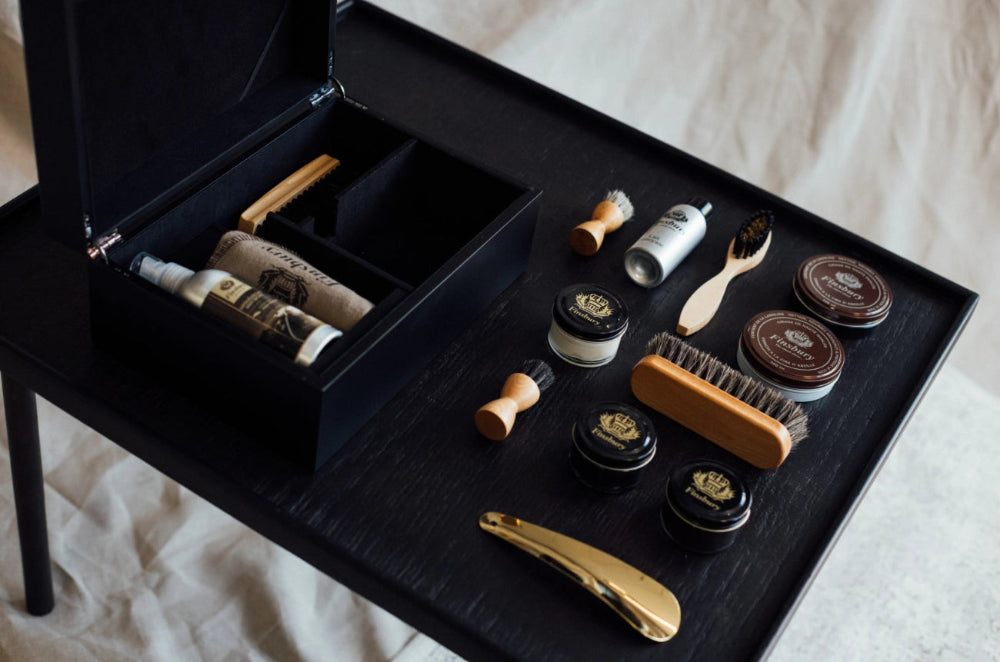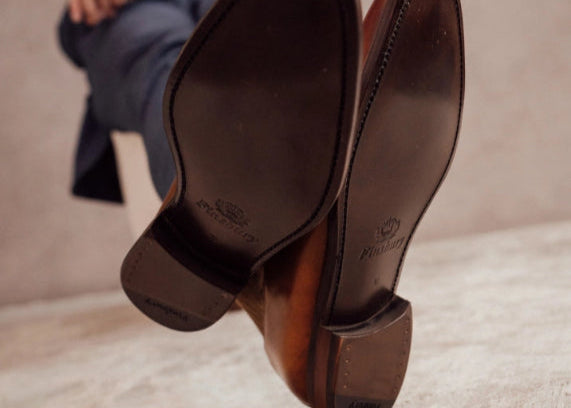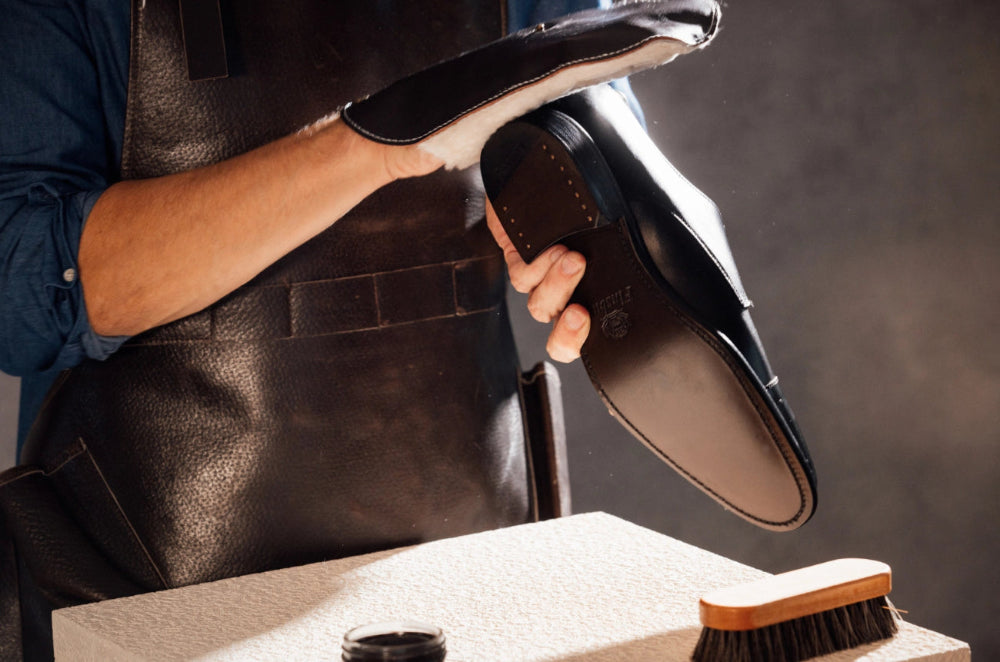Discover our 5 expert tips for maintaining your Finsbury shoes: shoe trees, alternation, polishing, soles and glazing

Our Expert Advice for Maintaining Your Shoes
Expert advice
Wondering how to care for your shoes ? Remember that a pair of Finsbury shoes is made of a noble and natural material: leather! Leather ages and evolves over time, developing a patina while becoming more beautiful. However, it requires regular maintenance if you want to maximize its longevity. Without regular and proper care, your shoes could wear out prematurely and lose their beauty.
In all Finsbury stores in France or internationally, teams of passionate professionals will be happy, upon request, to provide you with the best "purist" maintenance advice in order to perfect your shoe culture. However, if you wish to delegate the maintenance of your shoes, due to lack of time to do it yourself, Finsbury offers you to entrust the maintenance and repair of your shoes to our traditional shoemaking workshop , located at 17 rue des Petits-Champs in Paris in the 1st arrondissement. All operations will be carried out by our "master shoemaker" Finsbury at preferential rates.

The Importance of Shoe Trees
Rightly considered the shoe hanger, the shoe tree must be used systematically for all your pairs of shoes.
It dries the leather by absorbing moisture from the shoe, minimizes unsightly walking creases and maintains the shape of the shoe by re-tightening the leather damaged by a day of walking.
For it to be effective it must:
- Be made of wood ! Its primary function is to absorb moisture, so it can't be made of plastic!
- Be used continuously as soon as you take off your shoes. Each pair must therefore be equipped with its own shoe tree.
- Be adapted to the size of the shoe. A good shoe tree should not be offered in 41-42 but rather in 41 or 42 .
- Be adapted to the shape of your shoe. The force of the shoe tree could deform a shoe if it is not adapted.

The alternation
This is not a care item but an essential attention for the longevity and proper aging of your shoes: a pair should never be worn two days in a row!
Leather is a natural material that needs rest! Ideally, it is recommended to use 4 or 5 pairs of shoes alternately, which will allow you to wear each one a maximum of 2 times per week. This will significantly optimize your comfort as well as the longevity of your shoes. It also becomes very economical because you will reduce your shoe budget! (This will also allow you to treat yourself by offering a more beautiful variety of colors in your own shoe collection)
Of course, when not being worn, your pair of shoes should be kept on their shoe tree!
Contrary to popular belief, it is imperative to put your shoe trees in your shoes as soon as you take them off (and not the next day) in order to absorb all the moisture present in the shoe. You should then only remove your shoe trees when you put them back on a few days later...

The virtues of regular shoe polishing
As leather is a living material, it is essential to moisturize it regularly to optimize its flexibility but also its waterproofness and longevity.
The correct frequency is to polish your shoes every 4 to 5 times they are worn. By following the alternation rules (RULE 2), this equates to polishing your shoes 2 to 3 times a month on average , or even every week if you only have two or three pairs.
It is important to use a quality shoe polish, made from beeswax, and presented in a metal tin. Any form of shoe polish with an applicator or sponge, or even liquid or spray products, should be avoided! Never use spray-on waterproofers! These are exclusively reserved for suede calfskin. Obviously, good quality shoe care products are rarely available in supermarkets. We strongly recommend using Finsbury products, whose formulas have been specially developed for our leathers, or purchasing them from a traditional shoe repair shop.
Finally, be careful not to over-polish your shoe. The amount of wax used per polishing should be small. Applying too much polish several times could leave white marks on your leather, preventing the pores from breathing. We also strongly recommend cleaning your shoes with Finsbury cleaning milk to remove all dirt, rain stains, and accumulated layers of polish from the leather surface. This will restore your shoes to their original shine.
A good shoe polish is applied with a soft cloth or Finsbury shoe polish pads. Gently apply the polish in a circular motion, always using small amounts, so that the wax penetrates the leather fibers. Let the polish dry for at least 15 minutes before polishing your shoes with a Finsbury horsehair brush (in practice, we recommend polishing them in the evening and shining them the next morning).
Also, remember to cream your shoes every two weeks to nourish the shoe leather.

Sole maintenance
Finsbury shoe soles are available in rubber or leather. The latter is a genuine leather sole that, just like the upper (top) of your shoe, requires regular and essential maintenance. Without maintenance, a sole may have an abnormally reduced lifespan, just as waterproofing in heavy rain cannot be guaranteed.
At the risk of upsetting the purists, two solutions are then available to you:
- The most traditional would be to grease your soles with mink oil. Reserved exclusively for your soles (do not put grease on the upper of your shoe) it will have the functions of optimizing the waterproofness of the sole, while optimizing its longevity but also of reinforcing the thread of the welt seam of the sole. It thus prevents these two elements from drying out and crumbling prematurely on contact with the ground.
Greasing is done in the evening using a soft, dry cloth. Apply a generous layer of grease to the part of the sole in contact with the ground (not necessary on the heel), taking care to work it in well. Then, let your pair dry on the edge for several days until the next time you wear them. This way, the leather of the sole will have penetrated deeply and more or less dried, allowing you to leave with your shoes on your feet (after this specific treatment, it is strongly recommended that you put your shoes back on on your landing so as not to damage your floors or carpets). This will also have another very appreciable effect concerning the flexibility of your shoe during use.
- The other, more widespread solution is to have a rubber pad (Topy) placed under your sole. Several advantages are highlighted by those who use this technique: flawless protection of the sole, maximum longevity of your soles by simplifying maintenance, reduced risk of slipping and more waterproof during winter and rainy periods.
On the other hand, there are some drawbacks that may be unpleasant for purists: The rubber sole will tend to make your shoe less flexible in use, which will have the effect of increasing the phenomenon of walking creases in your shoe. Since the sole no longer "works" as it should, walking creases are often more pronounced, leading to sometimes premature and unsightly aging of the upper.
Finally, to have a skate fitted, it is important to follow a few prerequisites to avoid any disappointment: Never fit a skate on a new shoe! In any case, you must wear your shoes for about ten days to soften them and to wear down the top coat of varnish on the sole as little as possible. Otherwise, ask your shoemaker to do a little preliminary sanding before fitting the skate, which should be as fine as possible. At the same time as this operation, we strongly recommend fitting a built-in iron on the front of the shoe only. This will protect the tip of your shoe while preventing the skate from coming off during use. Built-in, it will never make any noise when walking.

How to make a subtle icing?
Glazing is the ultimate shoe polishing technique. Reserved for the initiated, it will make you a true ambassador of masculine elegance.
“Shine your shoes is a mandatory act, polishing them is a cultural act.”
It all starts by preparing your shoes with a good brush to remove dust. A colorless cleaning milk is applied to rid the upper of impurities, the shoe must then be left to dry for a few moments. Then begins the polishing phase, which is applied in a circular motion using a damp (but not wet!) cloth stretched over your middle and index fingers. With a brush, all excess polish is removed. The glazing operation can then begin:
This technique involves mixing shoe polish and water in small amounts, with the ideal mixture being around 80%/20%. Your cloth should be barely damp at the tips of your fingers.
The gesture is carried out by a more or less wide circular movement, the contact of three simultaneous elements: polish/water/heat will crystallize the wax particles contained in your polish.
Repeat these movements as many times as necessary. If your leather remains matte, don't hesitate to add a little water.
In the end, your shoe will shine brilliantly on the toe and the counters. Your leather will be protected and will reveal a true depth of color with a marbled effect. Of course, the glaze will fade as the shoe is worn. It is recommended to wipe it with a soft cloth after each use and to repeat the glaze operation every 3 to 4 days of wearing the shoe.
Last expert advice, glazes on black shoes should be light, other shades of leather can be glazed more heavily to create a mirror effect.